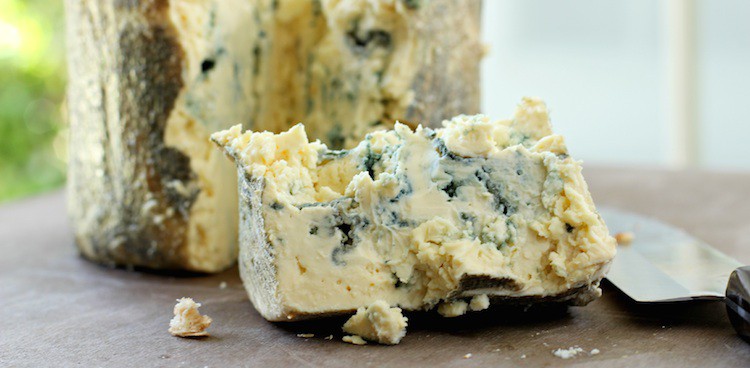
Blue cheese is one of those foods that has obtained a near mythical status. How else could you convince millions of people to consume moldy, curdled milk? As one of the world’s oldest and most revered cheeses, it is stinky, salty, and utterly delicious. But how did it get its start?
Moldy Origins
The term “blue cheese” is a general classification of a broad spectrum of cheeses from any type of milk, though the three classic styles of blue are Roquefort, Gorgonzola, and Stilton. Hailing from France, Italy, and England respectively, each has a different texture and taste from the others.
Roquefort is among the world’s oldest cheeses. Dating as far back as 79 C.E., it was a favorite of Charlemagne, and in France it’s referred to as le fromage des rois et des papes (“the cheese of kings and popes”). Similar to Champagne, only Roquefort made in Roquefort, France may be labeled as such. All other French blues are simply called “bleus.” It’s one of the more popular blues, and has even been credited with fending off cardiovascular disease.

Racks of aging Roquefort cheese. Photo from FranceToday.com
Though it’s unconfirmed, legend says that the first blue cheese was made accidentally when a shepherd left a piece of rye bread and a piece of cheese in a cool cave. The bread grew mold which spread to the aging cheese, and when the shepherd returned weeks later, he made a very delicious discovery.
Why so blue?
The blue in all blue cheeses comes from one of two species of blue mold: Penicillium roqueforti and Penicillium glaucum. They both feed on the proteins in milk and thrive in low oxygen environments, making them perfect guests in the small cracks and holes created when the cheese is skewered. Internally veined blue cheeses can acquire their veining in a couple of ways. Some are pierced by cheesemakers, leaving paths of air that allow the mold to grow into the interior. Others are known as “open rind,” which means that the curds are packed together in a way that leaves air paths into the interior of the cheese and the exterior of the cheese is infected with mold that then works its way in. While most blue cheeses internally veined, some blues like Monte Enebro are left whole, resulting in blue mold only on the rind.

Monte Enebro only has Penicillium roqueforti on the rind. Photo by Formaggio Kitchen.
While both Penicillium roqueforti and Penicillium glaucum commonly occur in nature, P. roqueforti is the more commonly used of the pair. You can buy freeze-dried mold spores online, or you can cultivate your own using an old chunk of blue cheese or even moldy bread.
How it’s Made
Blue cheese can be made from any type of milk. After the milk is heated, a starter culture is added, causing the milk to begin separating into curds and whey. Mold spores – which can be store-bought or home grown – are added, along with rennet and the milk is incubated for a short time. Once curds form, the cheese is pressed into an appropriate shape before being salted and air dried. Because blue molds are so fast growing, blue cheeses often have more salt in them than other varieties of cheese. This additional salt can slow the blue mold, allowing the cheese to age longer without becoming overwhelmingly blue.
As the cheese dries, the cheesemaker pierces the cheese from all sides in a task called “needling,” opening up the airy paths needed for the mold to grow in the interior of the cheese and producing the pretty veining that’s common in most blues. Finally, the cheese is left to age. How long it’s aged depends on personal taste, but many varieties are aged for around 2 months. Variances in a blue’s texture, taste, and smell can be controlled by the type of milk and mold used, the aging process, and even the shape of the cheese.

Needling blue cheese to allow for internal veining. Photo by WikiHow.com
How to Eat it
A blue cheese is often a strong, salty cheese, which can make it a bear to pair sometimes. Here are a few tried and true blue treats:
- In a glass: Since blues are fairly salty, pair with a sweeter dessert wine or a stout with chocolate notes.
- On the cheeseboard: Dried apricots or figs balance the strong flavor of blues, while crunchy almonds contrast with the creaminess of the cheese. For a more formal hors d’oeuvre, top a cracker with Gorgonzola and honeycomb for a perfect bite.
- In the kitchen: Try blues in a recipe like Mini Blue Cheese Ravioli, Buttermilk Blue Stuffed Dates, or Northern Lights Blue Cheese and Potato Tart.
Be sure to check out our Cheese Library for an extensive list of blue cheeses.




